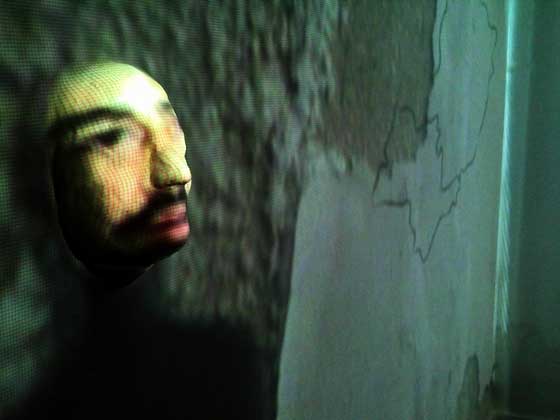BRAZIL
"DO SOFÁ DA SUA CASA", 2010
(instalação com videomapping | 2 walls, a Tv and a face plaster mask
were used to videomap the scenarium and narrative)
ARTIST'S MATERIAL:
[ENGLISH]
DO SOFA DA SUA CASA (from the sofa of your home) is a video installation that highlights the collective panic caused by Primeiro Comando da Capital (PCC) . Founded in 1993 by inmates of the Taubaté prison in São Paulo, PCC is a criminal organization that has been responsible for several criminal activities such as prison breaks, prison riots, drug trafficking, highway robbery and terrorist activities. Through the use of cellphones, media and internet from inside prison, PCC brought the city of São Paulo to a halt. DO SOFA DA SUA CASA places the spectator inside the living room to make him/ her think about their social/ political position about this and other media facts.
[PORTUGUÊS]
Como nos chega o mundo lá fora a partir do sofá de nossas casas? O que nos mostram as janelas ou tevês como interfaces de mediação, quando algo de estranho acontece no espaço exterior? Reais ou mediadas, as janelas dirigem nossos olhos a partir de recortes do mundo. Cada vez mais, câmeras portáteis e aparelhos celulares constituem as extensões capilares desse sistema de visão. E assim promovem efeitos inesperados, especialmente a partir de suas possibilidades de uso em rede. Por meio de articulações feitas com celulares dentro de cadeias em 15 de maio de 2006 a organização PCC parou a maior cidade da América Latina, numa data que ficou conhecida como ‘o dia em que São Paulo parou’. Em uma progressão de incidentes que culminaram em uma segunda feira fatídica para grande parte da população paulistana, integrantes do PCC articularam ataques a ônibus, bancos e bases da PM na cidade. A instalação Do Sofá da Sua Casa reconstitui através de vídeos mapeados em um cenário doméstico, o pânico vivido por milhões de pessoas diante do espetáculo midiático que se seguiu aos ataques. São vídeos que contrapõem diferentes pontos de vista, que fazem oscilar a noção de verdade embutida nos registros visuais: em imagens dos ataques encontradas em hipotéticos celulares perdidos, através de uma suposta conversa com um integrante do PCC em crise de consciência, a cena de um ônibus sendo queimado até o fim, as linhas de varredura de uma TV que desenha os fatos de forma fragmentada, por sobreposição e excesso.
[BIO]
[CURATORSHIP TXT EXTRACT]
This sense of surveillance reversion, or shattering, when it is not even possible to say from and to where it is being exerted, is what we want to underline in the work of Lucas Bambozzi and Paloma de Oliveira. Conceived also as a re-enactment of an event – the attacks that the criminal organization PCC ordered in São Paulo - Do Sofá da sua casa (2010) presents an installation consisting of a video-mapping in a domestic scenario, thematizing the production of the images within a network and creating an experience of shared tension of “the day that São Paulo stopped”1. The event that is the matrix of the work brings the elements of a shattered landscape, in that the actions coordinated around the city were orchestrated overall via phone calls originating from within the prisons. A place of surveillance, reclusion and control par excellence became thus the basis for communications and actions against Latin America’s largest city. Blatantly exposing the fragility of the Brazilian prison system, the episode casts shame on the promoters of mobile networks, when it gains a visibility and a propagation that publicity campaigns could never produce. In addition to this, the media capitalizing of panic - above all by television - amplified the chain of images and senses linked to the events. In this work reappears the problem of the veracity of the visual recordings in a context in which surveillance processes cannot be dissociated from the spreading of quotidian vision and recording technologies. Instead of the emblematic CFTV, cell phones and media images compose networks through which propagate images and discourses whose connections are at the same time of control and decontrol, power and anti-power, surveillance and sous-veillance, entertainment and panic.
[TRECHO DO TXT CURADORIA]
Este sentido de reversão da vigilância, ou antes de um estilhaçamento, já não sendo mais possível dizer de onde e para onde ela se exerce, é o que gostaríamos de pontuar na obra dos brasileiros Lucas Bambozzi e Paloma Oliveira. Concebida também como re-encenação de um acontecimento - os ataques da facção criminosa PCC na cidade de São Paulo – Do Sofá da sua casa (2010) apresenta uma instalação elaborada a partir de um videomapping sobre um cenário doméstico, tematizando a produção de imagens em rede e criando uma experiência compartilhada da tensão do “dia em que São Paulo parou" 1. O acontecimento que seria a “matriz” da obra já traz elementos de uma paisagem estilhaçada, uma vez que ações coordenadas por toda a cidade foram orquestradas sobretudo através de ligações de telefones celulares desde as prisões. O lugar de vigilância, reclusão e controle por excelência, torna-se a base para comunicações e ações na maior cidade da América Latina. Além de escancarar os frágeis limites da instituição prisional brasileira, o episódio deixa envergonhados os promotores da telefonia móvel, ganhando uma visibilidade e uma propagação que a publicidade jamais conseguiu produzir. Soma-se a isso a capitalização midiática do pânico, sobretudo pela televisão, ampliando a cadeia de imagens e sentidos ligados aos acontecimentos. Reaparece nesta obra o problema da veracidade dos registros visuais num contexto em que os processos de vigilância não podem ser dissociados do espraiamento das tecnologias de visão e registro do cotidiano. Em vez do emblemático circuito fechado de televisão, telefones celulares e imagens midiáticas compõem redes por onde se propagam imagens e discursos cujas conexões são a um só tempo de controle e descontrole, de poder e contra-poder, de vigilância e contra-vigilância, de entretenimento e pânico.
